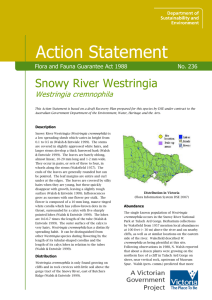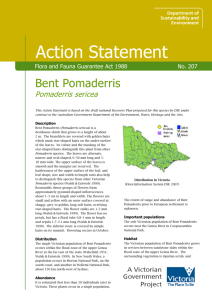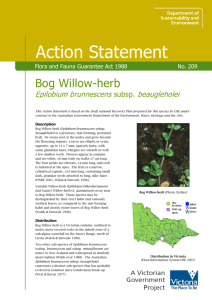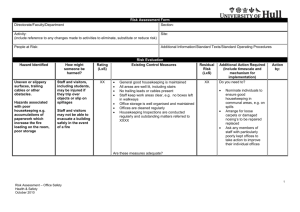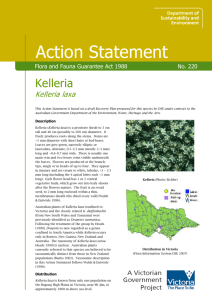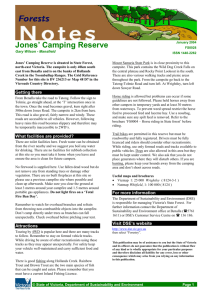Conservation status - Department of Environment, Land, Water and
advertisement
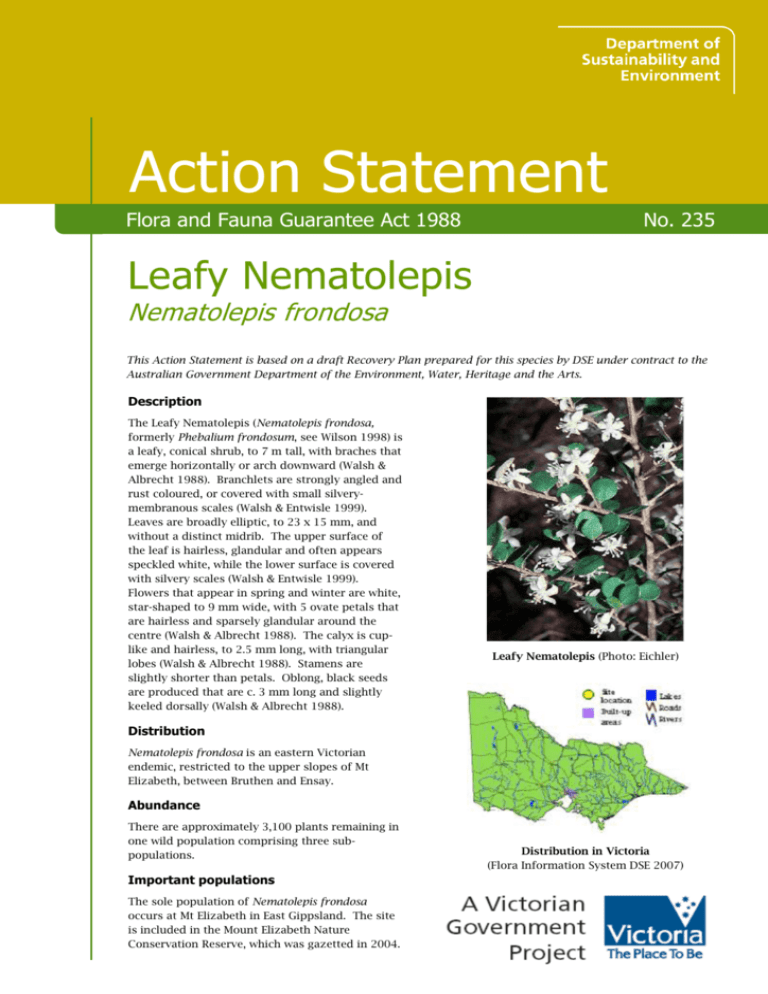
Action Statement Flora and Fauna Guarantee Act 1988 No. 235 Leafy Nematolepis Nematolepis frondosa This Action Statement is based on a draft Recovery Plan prepared for this species by DSE under contract to the Australian Government Department of the Environment, Water, Heritage and the Arts. Description The Leafy Nematolepis (Nematolepis frondosa, formerly Phebalium frondosum, see Wilson 1998) is a leafy, conical shrub, to 7 m tall, with braches that emerge horizontally or arch downward (Walsh & Albrecht 1988). Branchlets are strongly angled and rust coloured, or covered with small silverymembranous scales (Walsh & Entwisle 1999). Leaves are broadly elliptic, to 23 x 15 mm, and without a distinct midrib. The upper surface of the leaf is hairless, glandular and often appears speckled white, while the lower surface is covered with silvery scales (Walsh & Entwisle 1999). Flowers that appear in spring and winter are white, star-shaped to 9 mm wide, with 5 ovate petals that are hairless and sparsely glandular around the centre (Walsh & Albrecht 1988). The calyx is cuplike and hairless, to 2.5 mm long, with triangular lobes (Walsh & Albrecht 1988). Stamens are slightly shorter than petals. Oblong, black seeds are produced that are c. 3 mm long and slightly keeled dorsally (Walsh & Albrecht 1988). Leafy Nematolepis (Photo: Eichler) Distribution Nematolepis frondosa is an eastern Victorian endemic, restricted to the upper slopes of Mt Elizabeth, between Bruthen and Ensay. Abundance There are approximately 3,100 plants remaining in one wild population comprising three subpopulations. Important populations The sole population of Nematolepis frondosa occurs at Mt Elizabeth in East Gippsland. The site is included in the Mount Elizabeth Nature Conservation Reserve, which was gazetted in 2004. Distribution in Victoria (Flora Information System DSE 2007) Habitat confined to a single locality site (comprising 3 subpopulations), and is susceptible to fires at frequencies too short to allow replenishment of the soil seedbank (<5 years). Populations of Nematolepis frondosa occur in varied habitat on Mt Elizabeth, ranging from low rock outcrop scrub near the mountain summit, to tall open forest dominated by Mountain Ash (Eucalyptus regnans). Associated species within the rock outcrop scrub include Burgan (Kunzea ericoides), Hazel Pomaderris (Pomaderris aspera), Prunus Pomaderris (Pomaderris prunifolia) and Wedge-leaf Everlasting (Ozothamnus cuneifolius). Tall open forest sites on lower slopes contain Silver Wattle (Acacia dealbata), Snowy Daisy-bush (Olearia lirata), Monkey Mint-bush (Prostanthera walteri) and Stinkwood (Zieria arborescens). The topography varies from flat to moderately steep on south, southwesterly, north, northwesterly and westerly aspects. The soils vary from skeletal at the summit population, to deep mountain loams near the saddle, on rhyolitic or granodiorite parent material (Walsh & Albrecht 1988). The altitudinal range is approximately 820-960 m above sea level (Walsh & Albrecht 1988). Conservation status National conservation status Nematolepis frondosa is listed as ‘vulnerable’ under the Commonwealth Environment Protection and Biodiversity Conservation Act 1999. Victorian conservation status Nematolepis frondosa has been listed as ‘threatened’ under the Victorian Flora and Fauna Guarantee Act 1988. It is considered ‘vulnerable’ in Victoria according to DSE’s Advisory List of Rare or Threatened Vascular Plants in Victoria – 2005 (DSE 2005). Potentially threatening processes Inappropriate biomass reduction / fire regimes Fires occurring at intervals less than five years are likely to destroy plants before they are old enough to produce seed to replenish the soil seedbank and reduce likelihood of further recruitment or regeneration. Life history and ecology There have been no specific ecological or biological studies of Nematolepis frondosa. Nothing is known of its ecological characteristics, such as fire behaviour, longevity of plants or soil-stored seed, or pollination biology. Previous management action The single known population is largely even-aged and relatively large, but disturbance at the site tends to promote more or less continuous recruitment. However, the whole population is Mt Elizabeth locations have been surveyed and plants counted. Seed has been collected and stored at the Royal Botanic Gardens. Long term objective To ensure that Nematolepis frondosa can survive, flourish and retain its potential for evolutionary development in the wild. Specific objectives, actions and targets The intended management actions listed below are further elaborated in DSE’s Actions for Biodiversity Conservation (ABC) system. Detailed information about the actions and locations, including priorities, is held in this system and will be provided annually to land managers and other authorities. Objective I To increase knowledge of biology, ecology and management requirements Action Targets 1. Acquire baseline population data. Conduct detailed field and desk top surveys including identification of the area and extent of the population; estimates of the number, size and structure of the population, and inference or estimation of population change. Updated records on all State databases (FIS, VROTPop and Herbarium). Target populations accurately mapped. Assess habitat characteristics and/or condition. Accurately survey known habitat and collect and analyse floristic and environmental information relevant to community ecology and condition. Ecological requirements identified for the completion of essential life history stages, recruitment and dispersal. Core habitat mapped. 2. Responsible DSE DSE 2 3. Conduct survey to locate suitable habitat. Identify and survey potential habitat, using ecological and bioclimatic information that may indicate habitat preference. Predictive model for potential habitat developed and tested. DSE 4. Identify disturbance regimes to maintain habitat or promote regeneration and recruitment. Management prescriptions for ecological burning at the Mt Elizabeth site prepared. DSE 5. Undertake research to identify key biological functions. Evaluate current reproductive / regenerative status, seed bank status and longevity, fecundity and recruitment levels by conducting field based experimental trials. Determine seed germination requirements by conducting laboratory and field trials aimed to identify key stimuli. Seed bank/regenerative potential quantified for population. DSE Stimuli for recruitment/regeneration identified. Management strategies identified to maintain, enhance or restore regenerative processes fundamental to reproduction and survival. Analyse population trends. Measure population trends and responses against recovery actions by collecting demographic information including recruitment and mortality, timing of life history stages and morphological data. Collate, analyse and report on census data and compare with management histories. Techniques for monitoring developed and implemented. Census data for target populations. Population growth rates determined. Population Viability Analysis completed for targeted populations. 6. Objective II To secure populations or habitat from potentially incompatible land use or catastrophic loss. Action Targets 7. Establish cultivated plants ex situ to safeguard from the unforeseen destruction of the wild population. Development of effective propagation and cultivation techniques. At least 30 mature plants in cultivation. Liaise with government agencies. Ensure that information and advice about the recovery of Leafy Nematolepis has been provided to public land managers, local government authorities and Catchment Management Authorities. All relevant authorities and public land managers are aware of the species and its management needs. Information and advice about the recovery of Leafy Nematolepis has been regularly shared with Parks Victoria. 8. Objective III Responsible Royal Botanic Gardens DSE To increase the number of populations or individuals Action Targets 9. Determine seed viability. Objective IV DSE Seed viability determined. Responsible Royal Botanic Gardens, DSE To increase community awareness and support Action Targets 10. Involve community groups and volunteers in recovery activities. Opportunities for involvement identified, promoted and supported. Responsible DSE 3 References DSE (2005) Advisory List of Rare or Threatened Vascular Plants in Victoria – 2005. Department of Sustainability and Environment, East Melbourne, Victoria. DSE (2004) Flora Information System 2004, Department of Sustainability and Environment. Walsh, N.G. & Albrecht, D.E. (1988) Three new species of Phebalium Vent. Sect. Eriostemoides Endl. (Rutaceae) from south-eastern Australia, Muelleria, 6(6): 399-409. Walsh, N.G. & Entwisle, T.J. (1996) Flora of Victoria, Vol 3: Dicotyledons: Winteraceae to Myrtaceae, Inkata Press, Melbourne. Walsh, N.G. & Entwisle, T.J. (1999) Flora of Victoria, Vol 4: Dicotyledons: Cornaceae to Asteraceae, Inkata Press, Melbourne. Wilson, P.G. (1998) New species and nomenclatural changes in Phebalium and related genera (Rutaceae), Nuytsia, 12(2) 267-288. This Action Statement has been prepared under section 19 of the Flora and Fauna Guarantee Act 1988 under delegation from Mr Peter Harris, Secretary, Department of Sustainability and Environment, July 2008. Published by the Victorian Government Department of Sustainability and Environment Melbourne, July 2008 © The State of Victoria Department of Sustainability and Environment 2008 This publication is copyright. No part may be reproduced by any process except in accordance with the provisions of the Copyright Act 1968. Authorised by the Victorian Government, 8 Nicholson Street, East Melbourne. ISSN 1448-9902 For more information contact the DSE Customer Service Centre 136 186 Disclaimer This publication may be of assistance to you but the State of Victoria and its employees do not guarantee that the publication is without flaw of any kind or is wholly appropriate for your particular purposes and therefore disclaims all liability for any error, loss or other consequence which may arise from you relying on any information in this publication. Accessibility If you would like to receive this publication in an accessible format, such as large print or audio, please telephone 136 186, 1800 122 969 (TTY), or email customer.service@dse.vic.gov.au This document is also available in PDF format on the Internet at www.dse.vic.gov.au 4
